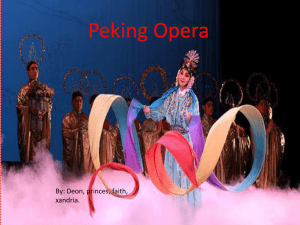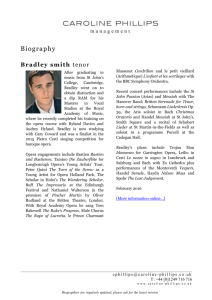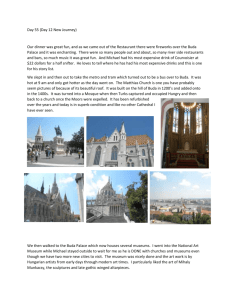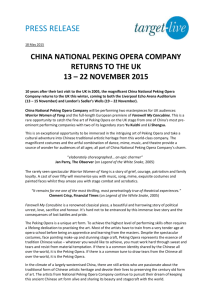Quiz on Peking Opera
advertisement
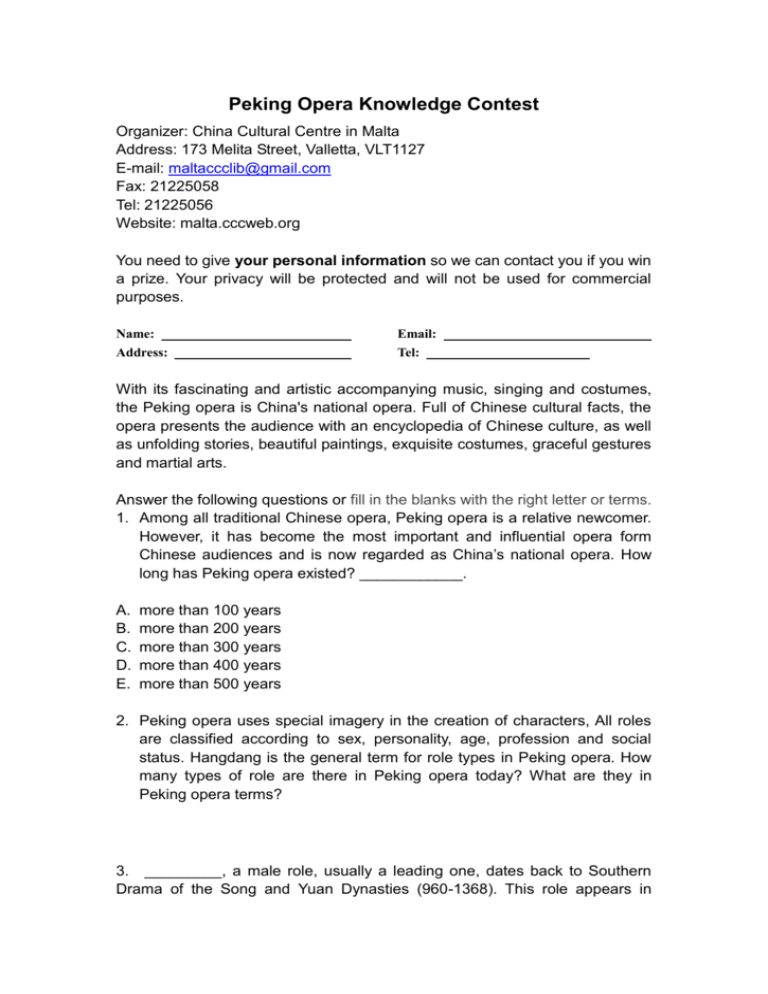
Peking Opera Knowledge Contest Organizer: China Cultural Centre in Malta Address: 173 Melita Street, Valletta, VLT1127 E-mail: maltaccclib@gmail.com Fax: 21225058 Tel: 21225056 Website: malta.cccweb.org You need to give your personal information so we can contact you if you win a prize. Your privacy will be protected and will not be used for commercial purposes. Name: Address: Email: Tel: _ With its fascinating and artistic accompanying music, singing and costumes, the Peking opera is China's national opera. Full of Chinese cultural facts, the opera presents the audience with an encyclopedia of Chinese culture, as well as unfolding stories, beautiful paintings, exquisite costumes, graceful gestures and martial arts. Answer the following questions or fill in the blanks with the right letter or terms. 1. Among all traditional Chinese opera, Peking opera is a relative newcomer. However, it has become the most important and influential opera form Chinese audiences and is now regarded as China’s national opera. How long has Peking opera existed? ____________. A. B. C. D. E. more than 100 years more than 200 years more than 300 years more than 400 years more than 500 years 2. Peking opera uses special imagery in the creation of characters, All roles are classified according to sex, personality, age, profession and social status. Hangdang is the general term for role types in Peking opera. How many types of role are there in Peking opera today? What are they in Peking opera terms? 3. _________, a male role, usually a leading one, dates back to Southern Drama of the Song and Yuan Dynasties (960-1368). This role appears in operas in all historical periods. According to the age and social status of the characters, it falls into five sub-groups: ___________, __________, __________, __________, __________. 4. ________also known as Xusheng, meaning bearded, because the actors wear artificial beards, as they are middle-aged or elderly men. Most are upright and resolute characters. They sing in their natural voices, and their actions are serious ones. 5. ___________roles are those of young men in Peking opera. They are clean-shaven and look fine and handsome. The most distinctive feature of this role’s performance is the combination of real and false voices in the singing and speaking which distinguish the characters of young men from those of elderly men. 6. __________ stands for all of the male characters who appear in battle scenes. They always wear helmets and thick-soled boots. The generals always carry long pikes. These roles call for sturdy and vigorous actions, with resounding declamations. The movements of the waist and legs are powerful, and a high level of martial arts skills is demanded in these roles. 7. The female role in Peking opera is divided into qingyi, wudan, huadan and Laodan. Which one refers to young or middle-aged women with gentle and refined dispositions and most of their lines delivered in song, and even the spoken parts recited in rhythmic style? 8. The _____ is a romantic, exaggerated type of Peking opera role. The characters are mostly cheerful, honest, gallant and intrepid men or treacherous and cruel men. These characters wear colorful paint on their faces, so they are also known as ________ (meaning “painted face”) 9. _____ characters are humorous or insidious men, or men who have low social status. In general, the roles do not focus on singing, but the dialogue is clear and fluent. This type of role is divided into two categories: _______(comic civilian roles) and ________ (martial comic roles). Both have their own special features. 10. Among the many excellent actors and actresses to have specialized in dan roles in the history of Peking opera are the famous “Four Great Dan Actors”. They made significant contributions to the performance of dan roles, enriching Peking opera and helping it develop. Who are they? 11. Facial makeup in Peking opera is a uniquely Chinese makeup style. The facial makeup shows the character’s personality and type in two ways: colour and shape. One major feature of Peking opera is how a character’s temperament, personality, role and fate are symbolized by a certain colour of face paint. This is also a key to helping the audience understand the plot. Which colour face represents loyalty and gallantry? _________. Which colour face represents an unyielding nature, uprightness, bravery and sometimes rashness? __________. Which colour faces are generally used for treacherous ministers and vicious men? ___________________. Which colour faces are used for mysterious immortals and spirits? _______________. 12. Name at least five main musical instruments of Peking opera. 13. Name at least five main props in Peking opera. 14. There are four lessons and five techniques every Peking opera actor must master. What do the four lessons and the five techniques mean in Peking opera? 15. Peking opera is a comprehensive art. Feelings and ideas are often expressed through symbolic motions, and the unique format has developed over long years of performance. Using its standardized yet flexible format, many Peking opera artists have created a lot of vivid, touching characters with distinct personalities, thus helping Peking opera develop and prosper. When will a lecture on Peking opera be presented at the Sir Temi Zammit Hall of Malta University by Zhu Shihui, famous performing artist of Beijing Opera and when will two Art Evening Shows of Beijing opera be held at Teatru Manoel?
